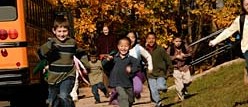2014 National Household Education Survey (NHES) After School Programs and Activities (ASPA) Cognitive Interviews
NCES Cognitive, Pilot, and Field Test Studies System
NHES ASPA 2014 Cog Labs Draft Questionnaire for Testing
2014 National Household Education Survey (NHES) After School Programs and Activities (ASPA) Cognitive Interviews
OMB: 1850-0803
NHES ASPA 2014 Draft Questionnaire
OMB No. 1850-0803
The National Household Education Survey A Survey about Students’ After-School Activities |



Thank you for helping us with this survey. Based on the information we received from your household in your last survey, we’re asking you to complete this final step.

UNITED STATES DEPARTMENT OF COMMERCE
Economics and Statistics Administration
U.S. Census Bureau
Conducted by
Instructions
Please answer all the survey questions thinking about this child or youth.
|
We are authorized to collect this information by 20 U.S. Code, Section 9543. You do not have to provide the information requested. However, the information you provide will help the Department of Education’s ongoing efforts to learn more about the educational experiences of children and families. There are no penalties should you choose not to participate in this study. Your answers may be used only for statistical purposes and may not be disclosed, or used, in identifiable form for any other purpose except as required by law (20 U.S. Code, Section 9573). Your responses will be combined with those from other participants to produce summary statistics and reports.
According to the Paperwork Reduction Act of 1995, no persons are required to respond to a survey unless it displays a valid OMB control number. The valid OMB control number for this voluntary survey is 1850–[XXXX]. The time required to complete this survey is estimated to average 20 minutes, including the time to review instructions, and complete and review the survey. If you have any comments concerning the accuracy of the time estimate, suggestions for improving this survey, or any comments or concerns regarding the status of your individual submission of this survey, please write to: Sarah Carroll, National Center for Education Statistics, 1990 K Street, NW, Room 9079, Washington, DC 20006. Please do not return the completed form to this address.

1. Child’s Schooling |
► Thank you for your help with the previous survey your household completed.
► Answer all the survey questions thinking about the child listed below:
1. What is this child’s current grade or year of school?
If this child is not assigned a specific grade, mark or write the grade he/she would be in at a school with regular grades.
Child has not yet started kindergarten


Please STOP now and call 1-888-XXX-XXXX.
Full-day kindergarten
Partial-day kindergarten

grade (1 through 12)
2. Is this child homeschooled instead of going to a public or private school for some classes or subjects?
No
Yes – For how many hours

each week does this child attend a public or private school?
3. What type of school does this child attend?

Private, Catholic

GO TO question 6
Private, religious
but not Catholic
Private, not religious

Public school
4. Is it his/her regularly assigned school?
No
Yes

5. Is this school a charter school?
No
Yes
6. How much do you agree or disagree with the following statement:
“This child enjoys school.”
Strongly agree
Agree
Disagree
Strongly disagree
7. Please tell us about this child’s grades during this school year. Overall, across all subjects, what grades does this child get?
Mostly A’s
Mostly B’s
Mostly C’s
Mostly D’s and lower
This child’s school does not give these grades
8. Since the beginning of this school year, how many times have any of this child’s teachers or school staff contacted your household about…
Write ‘0’ if none.
Number
a. |
Behavior problems this child is having in school |
|
b. |
Problems this child is having with school work |
|
c. |
Very good behavior |
|
d. |
Very good school work |
|


9. Since the beginning of this school year, how many days has this child been absent from school?

days
10. Since starting kindergarten, has this child repeated any grades?


GO TO question 12
No

Yes
11. What grade or grades did he/she repeat?

Mark all that apply.
Elementary through Middle school
Kindergarten
First grade
Second grade
Third grade
Fourth grade
Fifth grade
Sixth grade
Seventh grade
Eighth grade
High school
Ninth grade - freshman
Tenth grade - sophomore
Eleventh grade - junior
Twelfth grade - senior
12. Has this child ever had the following experiences?

Mark ONE box for each item below.
|
|
No ▼ |
Yes ▼ |
a. |
An out-of-school suspension |
|
|
b. |
An in-school suspension not counting detentions |
|
|
c. |
Been expelled from school |
|
|
13. How far do you expect this child to go in his/her education?

Mark ONE only.
Complete less than a high school diploma
Graduate from high school
Attend a vocational or technical school after high school
Attend two or more years of college
Earn a bachelor’s degree
Earn a graduate degree or professional degree beyond a bachelor's
14. How would you describe his/her work at school?

Mark ONE only.
Excellent
Above average
Average
Below average
Failing

2. Choosing After-School Arrangements |
Children spend their after-school time in many different ways. Some children are with parents or relatives after-school, some care for themselves, and others attend a supervised care program or participate in clubs, lessons, sports or other organized activities. After-school hours are the hours after the child is finished with school and weekends.
These next questions ask about what is important to your family when deciding how this child spends his or her time after-school.
15. Do you feel there are good choices for after-school care, programs, or activities where you live?
No
Yes
Don’t know
16. Does your child’s school or your local community provide information about after-school care, programs, or activities where you live?
No
Yes
Don’t know
17. Have you looked for information about after-school care, programs, or activities for your child?
No
Yes

18. How satisfied are you with the actual after-school care, programs, and activities available to you in your community?
Very satisfied
Somewhat satisfied
Somewhat dissatisfied
Very dissatisified
19. Are you or this child’s other parent at home each day when this child gets home from school?
No
Yes
20. Not counting times when an adult is at home and this child is outside playing, is this child responsible for him or herself each day for 30 minutes or more after school?
No
Yes
21. How important was each of the following reasons when your family was making decisions about where this child spends after-school hours and weekends? Mark
|
|||||
|
Not at all important |
A little important |
Somewhat important |
Very important |
Not applicable |
A convenient location………..…………. |
|
|
|
|
|
Cost ….…………………….……………… |
|
|
|
|
|
Adult supervision..................................... |
|
|
|
|
|
A safe environment................................. |
|
|
|
|
|
A nurturing environment………….……... |
|
|
|
|
|
Child is cared for by someone your family knows…………………..………….. |
|
|
|
|
|
Transportation to and from the care, program, or activity…………………........ |
|
|
|
|
|
All of your children can be at the same place |
|
|
|
|
|
The hours and schedule are convenient. |
|
|
|
|
|
Quality of facilities………………….…….. |
|
|
|
|
|
The provider is licensed or accredited.… |
|
|
|
|
|
Ability of someone to speak child or family’s first language……………............ |
|
|
|
|
|
Ability of someone to care for child’s special needs……………............ |
|
|
|
|
|
Adequate number of staff…………..….... |
|
|
|
|
|
No other care/programs available..…….. |
|
|
|
|
|
22. Other than the reasons above, how important was each of the following reasons when your family was making decisions about where this child spends after-school hours and weekends? Mark
|
|||||
|
Not at all important |
A little important |
Somewhat important |
Very important |
Not applicable |
Child enjoys it …………………... |
|
|
|
|
|
Child spends time with other kids his/her age………………………………... |
|
|
|
|
|
Child spends time with family…..…… |
|
|
|
|
|
Cultural diversity of the children….……. |
|
|
|
|
|
Provides music, art, and culture..………. |
|
|
|
|
|
Provides access to computers …………. |
|
|
|
|
|
Provides math and science activities …………..….. |
|
|
|
|
|
Provides academic support/tutoring……. |
|
|
|
|
|
Provides help for this child to learn English……………...……………….…….. |
|
|
|
|
|
Provides help for this child to learn another language |
|
|
|
|
|
Provides reading activities………..… |
|
|
|
|
|
Provides physical activities…………..…. |
|
|
|
|
|
Provides mentors or role models……..… |
|
|
|
|
|
You or your family like the staff…………. |
|
|
|
|
|
Religious affiliation of program…...…….. |
|
|
|
|
|
23. Other than the reasons listed above, were there any other reasons your family considered when making making decisions about where this child spends after-school hours and weekends?
|
24. During last week (or the most recent typical week) this school year, where was this child after school hours and weekends?
For
each day of the week below, mark
|
|||||||
Child spends at least 30 minutes… |
Monday |
Tuesday |
Wednesday |
Thursday |
Friday |
Saturday |
Sunday |
a. At this child's home
|
□ |
□ |
□ |
□ |
□ |
□ |
□ |
b. At another home
|
□ |
□ |
□ |
□ |
□ |
□ |
□ |
c. At this child’s school
|
□ |
□ |
□ |
□ |
□ |
□ |
□ |
d. At a community center |
□ |
□ |
□ |
□ |
□ |
□ |
□ |
e. At a day-care or after-school care center located in its own building |
□ |
□ |
□ |
□ |
□ |
□ |
□ |
f. At a college or university
|
□ |
□ |
□ |
□ |
□ |
□ |
□ |
g. At a library
|
□ |
□ |
□ |
□ |
□ |
□ |
□ |
h. At a church, synagogue, temple, or other place of worship
|
□ |
□ |
□ |
□ |
□ |
□ |
□ |
i. At a parent or guardian’s workplace
|
□ |
□ |
□ |
□ |
□ |
□ |
□ |
j. At another location not listed, specify:
|
□ |
□ |
□ |
□ |
□ |
□ |
□ |
|
25. During last week (or the most recent typical week) this school year, who looked after this child after school and weekends?
For
each day of the week, mark
|
|||||||||||||||
|
Child spends at least 30 minutes with… |
Monday |
Tuesday |
Wednesday |
Thursday |
Friday |
Saturday |
Sunday |
||||||||
|
a. Mother
|
□ |
□ |
□ |
□ |
□ |
□ |
□ |
||||||||
|
b. Father
|
□ |
□ |
□ |
□ |
□ |
□ |
□ |
||||||||
|
c. Grandmother or grandfather
|
□ |
□ |
□ |
□ |
□ |
□ |
□ |
||||||||
|
d. Aunt or uncle
|
□ |
□ |
□ |
□ |
□ |
□ |
□ |
||||||||
|
e. Brother or sister
|
□ |
□ |
□ |
□ |
□ |
□ |
□ |
||||||||
|
f. Another relative not listed
|
□ |
□ |
□ |
□ |
□ |
□ |
□ |
||||||||
|
g. Child takes care of him/herself for more than 30 minutes
|
□ |
□ |
□ |
□ |
□ |
□ |
□ |
||||||||
|
h. A nanny, babysitter, or another person not related to the child
|
□ |
□ |
□ |
□ |
□ |
□ |
□ |
||||||||
i. An adult staff person at a formal after-school program or center
|
□ |
□ |
□ |
□ |
□ |
□ |
□ |
|
||||||||
j. An adult at an organized club, sports or activity (e.g., coach, art teacher)
|
□ |
□ |
□ |
□ |
□ |
□ |
□ |
|
||||||||
26. During last week (or the most recent typical week) this school year, which of the following activities did this child do after school and weekends, if any?
For
each day of the week, mark
|
|||||||
|
Monday |
Tuesday |
Wednesday |
Thursday |
Friday |
Saturday |
Sunday |
a. Receives tutoring
|
□ |
□ |
□ |
□ |
□ |
□ |
□ |
b. Reading or writing for fun |
□ |
□ |
□ |
□ |
□ |
□ |
□ |
c. Mathematics, like math labs or math clubs
|
□ |
□ |
□ |
□ |
□ |
□ |
□ |
d. Science, like science lab or science clubs
|
□ |
□ |
□ |
□ |
□ |
□ |
□ |
e. Engineering or technology, like computer programming or robotics
|
□ |
□ |
□ |
□ |
□ |
□ |
□ |
f. Homework
|
□ |
□ |
□ |
□ |
□ |
□ |
□ |
g. Music, like lessons, band, or chorus
|
□ |
□ |
□ |
□ |
□ |
□ |
□ |
h. Arts, like drawing, painting, performing, or dance lessons
|
□ |
□ |
□ |
□ |
□ |
□ |
□ |
i. School clubs, like yearbook, chess or debate team
|
□ |
□ |
□ |
□ |
□ |
□ |
□ |
j. Community activities, like 4-H and Scouts
|
□ |
□ |
□ |
□ |
□ |
□ |
□ |
k. A religious activity
|
□ |
□ |
□ |
□ |
□ |
□ |
□ |
l. Volunteering
|
□ |
□ |
□ |
□ |
□ |
□ |
□ |
27. During last week (or the most recent typical week) this school year, which of the following activities did this child do after school and on weekends, if any?
For
each day of the week, mark
|
|||||||
|
Monday |
Tuesday |
Wednesday |
Thursday |
Friday |
Saturday |
Sunday |
a. Sports (team or individual)
|
□ |
□ |
□ |
□ |
□ |
□ |
□ |
b. Physical activities, like jumping rope, biking, dancing
|
□ |
□ |
□ |
□ |
□ |
□ |
□ |
c. Other playing outdoors
|
□ |
□ |
□ |
□ |
□ |
□ |
□ |
d. Playing indoors |
□ |
□ |
□ |
□ |
□ |
□ |
□ |
e. Socializing with friends |
□ |
□ |
□ |
□ |
□ |
□ |
□ |
f. Watching TV or movies (includes things like, online streaming, Netflix, VHS, DVD, or Blu-ray) |
□ |
□ |
□ |
□ |
□ |
□ |
□ |
g. Playing video games, like computer games and games for Xbox, Wii, and PlayStation
|
□ |
□ |
□ |
□ |
□ |
□ |
□ |
h. Using a smartphone, computer, or tablet, for Facebook, Twitter, Instagram, or Internet browsing (Does not include computer games and homework)
|
□ |
□ |
□ |
□ |
□ |
□ |
□ |
i. Working at a job
|
□ |
□ |
□ |
□ |
□ |
□ |
□ |
j. Chores
|
□ |
□ |
□ |
□ |
□ |
□ |
□ |
k. Taking care of a sibling
|
□ |
□ |
□ |
□ |
□ |
□ |
□ |
l. Another activity not listed, Specify:
|
□ |
□ |
□ |
□ |
□ |
□ |
□ |

3. Formal After-School Programs
The Department of Education would like to know more information about formal after-school programs that children attend. These are programs that provide supervision and structured activities. These programs are usually held in a school or a center, and are different from individual activities like sports, scouts, clubs, or special lessons.
28. Is this child now attending an after-school program at a school or in a center, either on a scheduled or a drop-in basis, at least once each week?
No

Yes
29. In the past year, have you tried to enroll this child in an after-school program either at your child’s school or at another location?
No
Yes
30. What is the main reason you did not enroll this child in an after-school program in a school or center?
Mark
![]() ONE box
ONE box

Child was not eligible because of
grades
Child was not eligible because of age
Hours of the program(s) do not fit
family’s needs
Program(s) are too expensive

GOTO question 42
Program(s) were at capacity/full
Poor program quality
Felt child is unsafe
Does not meet child’s special needs
Staff does not speak child’s primary
language
Transportation was unavailable
Transportation was unsafe
Program(s) not available where I live
Other reason not to enroll this child
Specify: ______________________

31. How many different formal after-school programs does this child attend?
One
Two
Three or more
32. How many hours each week does this child spend at formal after-school program(s) or center(s) after school and on weekends?

hours each week
33. These next questions ask about the after-school program where this child spends the most time.
How much does your household pay for this child to go to this program, not counting any money that you may receive from others to help pay for care?
Write ‘0’ if your household does not pay for this program.




$ .00
Is that amount per…
Hour
Day
Week
Month
Year
Every 2 weeks


Other Specify:
34. How many children from your household is this amount for, including this child?
Do not pay for program
This child only
2 children
3 children
4 children
5 or more children

35. Do any of the following people, programs, or organizations help pay for this child to go to this program?

Mark ONE box for each item below.
|
|
No ▼ |
Yes ▼ |
a. |
A friend or relative of this child outside your household who provides money specifically for that program, not including general child support |
|
|
b. |
Temporary Assistance for Needy Families, or TANF |
|
|
c. |
Another social service, welfare, or child care agency |
|
|
d. |
An employer, not including a tax-free spending account for child care |
|
|
e. |
Someone else |
|
|
36. How many years/months has this child been attending this program?


years months
How often do you or another adult in your family talk to a staff member at this program?
Less than once a month
Once or twice a month
Once or twice a week
Three or more times a week
38. How would you rate the overall quality of this program?
Best I can imagine
Better than I had expected to find for my child
Good for my child
Good enough for my child, but not as good as I’d wished for
Not good enough for my child

39. How does this child get to the after-school program? Please specify:

40. Is this program run by his or her school?
No
Yes
41. How many programs does this child participate in that are run by his or her school?
None
One
Two
Three or more

4. Organized After-School Activities
The following questions ask about organized clubs or activities that this child might participate in outside of school hours that are not part of a formal after-school program. These might include activities such as organized sports, music lessons, scouts, or religious education.
42. Is this child participating in any organized clubs or activities after-school at least once each week?

No
Yes
43. How many hours each week does this child currently participate in activities or lessons after-school and weekends?

hours each week
44. Does this child’s participation in these activities help to cover the hours when you need adult supervision for him/her?
No
Yes

45. How much does your household pay for this child to participate in organized activities, not counting any money that you may receive from others to help pay for the activities?
Write ‘0’ if your household does not pay for these activities.




$ .00
Is that amount per…
Hour
Day
Week
Month
Year
Every 2 weeks


Other Specify:
46. How many children from your household is this amount for, including this child?
Do not pay for activities
This child only
2 children
3 children
4 children
5 or more children

47. Do any of the following people, programs, or organizations help pay for this child to go to these activities?

Mark ONE box for each item below.
|
|
No ▼ |
Yes ▼ |
a. |
A friend or relative of this child outside your household who provides money specifically for the activities, not including general child support |
|
|
b. |
Temporary Assistance for Needy Families, or TANF |
|
|
c. |
Another social service, welfare, or child care agency |
|
|
d. |
An employer, not including a tax-free spending account for child care |
|
|
e. |
Someone else |
|
|
48. How many years/months has this child been participating in organized activities after-school?


years months
49. How does this child get to the activities? Please specify:

50. How many activities does this child participate in that are run by his or her school?
None
One
Two
Three or more

51. How often do you or another adult in your family talk to a coach, supervisor, or staff member at this child’s after-school activities?
Less than once a month
Once or twice a month
Once or twice a week
Three or more times a week
5. Other Arrangements
52. How many hours each week is this child looked after by a relative other than this child’s parent (e.g. grandparent, brother, sister, or other relative) after and weekends?
Write 0 if child is not looked after by a relative.

hours each week
53. How many hours each week is this child responsible for himself/herself for more than 30 minutes after-school and weekends?
Write 0 if child is not responsible for himself/herself.

hours each week
54. How many hours each week is this child looked after by a nanny, babysitter, or another person not related to the child, after school and weekends?
Write 0 if child is not looked after by someone not related him or her.

hours each week

6. Child’s Health
55. In general, how would you describe this child’s health?
Excellent
Very good
Good
Fair
Poor
56. Has a health or education professional told you that this child has any of the following conditions?


Mark all that apply.
|
|
|
|
|
|
|
|
|
|
|
|
|
|
|
|
|
|
|
|
|
|
|
|
|
|
|
|
|
|
|
|
|
|
|
|
|
|
|
|
|
|
|
|
|
|
|
|
|
|
|
|
|
|
|
|

57. Did you mark any condition in question 56?


GO TO question 65
No

Yes
58. Is this child receiving services for his/her condition?


GO TO question 64
No

Yes
59. Are any of these services provided through an Individualized Education Program (IEP)?
No
Yes
60. Are any of these services provided during after-school hours or on weekends?


GO TO question 64
No
Yes
61. Who mainly provides services for this child after-school or on weekends?

Mark ONE box for each item below.
|
|
No ▼ |
Yes ▼ |
a. |
Your local school district |
|
|
b. |
A state or local health or social service agency |
|
|
c. |
A community center or organization |
|
|
c. |
A private doctor, clinic, or other health care provider |
|
|
62. Where does this child typically receive services during after-school and weekend hours?

At this child’s home
At another private home
At this child’s school
At an after-school center
At a hospital, doctor’s office, or clinic
Someplace else
63. During this school year, how satisfied or dissatisfied have you been with the services this child receives during after-school hours?
a. The service provider’s communication with your family?
Very satisfied
Somewhat satisfied
Somewhat dissatisfied
Very dissatisfied
Does not apply
b. The child’s service provider?
Very satisfied
Somewhat satisfied
Somewhat dissatisfied
Very dissatisfied
Does not apply
c. The facility’s ability to accommodate the child’s special needs?
Very satisfied
Somewhat satisfied
Somewhat dissatisfied
Very dissatisfied
Does not apply

d. The service provider’s commitment to help your child learn?
Very satisfied
Somewhat satisfied
Somewhat dissatisfied
Very dissatisfied
Does not apply
64. Does this child’s condition interfere with his/her ability to do any of the following things?

Mark ONE box for each item below.
Child no longer has condition
|
|
No ▼ |
Yes ▼ |
a. |
Learn................................... …. |
|
|
b. |
Participate in sports, clubs, or other organized activities......... |
|
|
c. |
Attend school on a regular basis........................................ |
|
|
d. |
Make friends............................ |
|
|
► Continue with question 65 on the next page.

7. Child’s Background
65. In what month and year was this child born?


 /
/
month year
66. Where was this child born?


GO TO question 68
One of the 50 United States or the District of Columbia

One of the U.S. territories
(Puerto Rico, Guam, American Samoa, U.S. Virgin Islands, or Mariana Islands)
Another country
67. How old was this child when he/she first moved to the 50 United States or the District of Columbia?

age
68. Is this child of Spanish, Hispanic, or Latino origin?
No
Yes
69. What is this child’s race? You may mark one or more races.
American Indian or Alaska Native
Asian
Black or African American
Native Hawaiian or other Pacific Islander
White
70. What is this child’s sex?
Male
Female

71. Does this child split his or her time between two households, for example, because of a joint custody arrangement?
Do not include vacation properties.
No
Yes
72. What language does this child speak most at home?

Mark ONE only.



GO TO question 74
Child is not able to speak
English

Spanish
A language other than English or Spanish
English and Spanish equally
English and another language equally
73. Is this child currently enrolled in English as a second language, bilingual education, or an English immersion program?
No
Yes
► Continue with section 8, on the next page.
8. Child’s Family |
If you are not the child’s parent or guardian, answer questions 75 to 95 about one of this child’s parents or guardians living in the household.
74. Is this parent or guardian the child’s…
Biological parent
Adoptive parent
Stepparent
Foster parent
Grandparent
Other guardian
75. Is this person male or female?
Male
Female
76. What is this person’s current marital status?

Mark ONE only.


GO TO question 79 64
Now married
Widowed
Divorced
Separated
Never Married
77. Is this person currently living with a
boyfriend/girlfriend or partner in this
household?

GO TO question 79 64
N
 o
oYes



No
Yes
79. What was the first language this parent or guardian learned to speak?

Mark ONE only.


GO TO question 82
English
Spanish
A language other than English or Spanish
English and Spanish equally
English and another language equally
80. What language does this person speak most at home now?

Mark ONE only.


GO TO question 82
English
Spanish
A language other than English or Spanish
English and Spanish equally
English and another language equally
81. How difficult is it for this person to participate in activities at this child's school because he/she speaks a language other than English?
Very difficult
Somewhat difficult
Not at all difficult
► Continue with question 82 on the next page.
82. Where was this parent or guardian born?



GO TO question 84
One of the 50 United States or the District of Columbia

One of the U.S. territories
(Puerto Rico, Guam, American Samoa, U.S. Virgin Islands, or Mariana Islands)
Another country
83. How old was this person when he or she first moved to the 50 United States or the District of Columbia?
age
84. Is this person of Spanish, Hispanic, or Latino origin?
No
Yes
85. What is this person’s race? You may mark one or more races.
American Indian or Alaska Native
Asian
Black or African American
Native Hawaiian or other Pacific Islander
White
 86.
What is the highest grade or level of school
86.
What is the highest grade or level of school
that this parent or guardian completed?

Mark ONE only.
8th grade or less
High school, but no diploma
High school diploma or equivalent (GED)
Vocational diploma after high school
Some college, but no degree
Associate’s degree (AA, AS)
Bachelor’s degree (BA, BS)
Some graduate or professional education, but no degree
Master’s degree (MA, MS)
Doctorate degree (PhD, EdD)
Professional degree beyond bachelor’s degree (MD, DDS, JD, LLB)
87. Is he or she currently attending or enrolled in a school, college, university, or adult learning center, or receiving vocational education or job training?
No
Yes
88. Which of the following best describes this person’s employment status?

Mark ONE only.
Employed for pay or income
Self-employed

GO TO question 91
Unemployed or

out of work

Full-time student
Stay at home

GO TO question 92
parent
Retired
Disabled or
unable to work

89. (If employed or self-employed) Does he or she mostly work a regular shift, regular shift other than during the day, variable shifts or works when work is available?

Mark ONE only.
Regular day shift most of the hours between 6 am to 6pm
A regular shift at times other than between 6 am and 6 pm
A variable shift-one that changes from days to evenings or nights
Where he/she chooses their own hours
Works when work is available
90. About how many hours per week does he or she usually work for pay or income, counting all jobs?



GO TO question 92
hours
91. (If unemployed or out of work) Has this parent or guardian been actively looking for work in the past 4 weeks?
No
Yes
92. In the past 12 months, how many months (if any) has this person worked for pay or income?

Months
93. Have this child’s after-school care needs influenced this person’s choice of job or work schedule in any way?
No
Yes
94. How old is this person?

age
 95.
How old was this person when he or she first became a
parent to any child?
95.
How old was this person when he or she first became a
parent to any child?

age
Don’t know
► Continue with question 96 on the next page.
 PARENT
2 LIVING IN HOUSEHOLD Answer questions 96 to tk
about a second parent or guardian living in the household.
PARENT
2 LIVING IN HOUSEHOLD Answer questions 96 to tk
about a second parent or guardian living in the household.
96. Is there a second parent or guardian living in this household?


GO TO question 100
No

Yes
97. Is this person the child’s…
Biological parent
Adoptive parent
Stepparent
Foster parent
Grandparent
Other guardian
98. Is this person male or female?
Male
Female
99. What is your current marital status?

Mark ONE only.


GO TO question 83 888488884 64
Now married
Widowed
Divorced
Separated
Never Married
100. Are you currently living with a
boyfriend/girlfriend or partner in this
GO
TO question 83 88 64
No

Yes

101. Are you currently in a registered domestic partnership or civil union?
No
Yes
102. What was the first language this parent or guardian learned to speak?

Mark ONE only.


GO TO question 88
English
Spanish
A language other than English or Spanish
English and Spanish equally
English and another language equally
103. What language does this person speak most at home now?

Mark ONE only.


GO TO question 88
English
Spanish
A language other than English or Spanish
English and Spanish equally
English and another language equally
104. How difficult is it for this person to participate in activities at this child's school because he/she speaks a language other than English?
Very difficult
Somewhat difficult
Not at all difficult
► Continue with question 105 on the next page.

105. Where was this parent or guardian born?


GO TO question 90
One of the 50 United States or the District of Columbia

One of the U.S. territories
(Puerto Rico, Guam, American Samoa, U.S. Virgin Islands, or Mariana Islands)
Another country
106. How old was this person when he or she first moved to the 50 United States or the District of Columbia?
age
107. Is this person of Spanish, Hispanic, or Latino origin?
No
Yes
108. What is this person’s race? You may mark one or more races.
American Indian or Alaska Native
Asian
Black or African American
Native Hawaiian or other Pacific Islander
White

 109. What
is the highest grade or level of school that this parent or
guardian completed?
109. What
is the highest grade or level of school that this parent or
guardian completed?
Mark [X] ONE only.
8th grade or less
High school, but no diploma
High school diploma or equivalent (GED)
Vocational diploma after high school
Some college, but no degree
Associate’s degree (AA, AS)
Bachelor’s degree (BA, BS)
Some graduate or professional education, but no degree
Master’s degree (MA, MS)
Doctorate degree (PhD, EdD)
Professional degree beyond bachelor’s degree (MD, DDS, JD, LLB)
110. Is he or she currently attending or enrolled in a school, college, university, or adult learning center, or receiving vocational education or job training?
No
Yes
111. Which of the following best describes this person’s employment status?

Mark ONE only.
Employed for pay or income
Self-employed

GO TO question 114
Unemployed or

out of work

Full-time student
Stay at home

GO TO question 115
parent
Retired
Disabled or
unable to work
 112.
(If employed or self-employed) Does he or she mostly
work a regular shift, regular shift other than during the day,
variable shifts or works when work is available?
112.
(If employed or self-employed) Does he or she mostly
work a regular shift, regular shift other than during the day,
variable shifts or works when work is available?

Mark ONE only.
Regular day shift most of the hours between 6 am to 6pm
A regular shift at times other than between 6 am and 6 pm
A variable shift-one that changes from days to evenings or nights
Where he/she chooses their own hours
Works when work is available
113. About how many hours per week does he or she usually work for pay or income, counting all jobs?



GO TO question 115
hours
114. (If unemployed or out of work) Has this parent or guardian been actively looking for work in the past 4 weeks?
No
Yes
115. In the past 12 months, how many months (if any) has this person worked for pay or income?

Months
116. Have this child’s after-school care needs influenced this person’s choice of job or work schedule in any way?
No
Yes

117. How old is this person?

age
118. How old was this person when he or she first became a parent to any child?

age
Don’t know
► Continue with section 9, question 119 on the next page.
9. Your Household |
119. How many of the following people live in this household with this child?

2
Example: Brother(s)
Write ‘0’ if none.
This child’s…. |
Number |
Parent(s)………….
Brother(s)………… |
|
Sister(s)…………... |
|
Aunt(s)…………….. |
|
Uncle(s)……………. |
|
Grandmother(s)…… |
|
Grandfather(s)…….. |
|
Cousin(s)…………… |
|
Parent’s girlfriend/ boyfriend/ partner… |
|
Other relative(s)…… |
|
Other non-relative(s) |
|
|
|
120. Enter the total number of people living in this household with this child. (This number should be equal to the sum of a through k above).


 121.
How are you related to this child?
121.
How are you related to this child?

Mark ONE only.
Mother (birth, adoptive, step, or foster)
Father (birth, adoptive, step, or foster)
Aunt
Uncle
Grandmother
Grandfather
Parent’s girlfriend/ boyfriend/ partner

Other relationship – Specify:

122. Which language(s) are spoken at home by the adults in this household?

Mark all that apply.
English
Spanish or Spanish Creole
French (including Patois, Creole, Cajun)
Chinese

Other languages – Specify:

► Continue with question 122 on the next page.

123. In the past 12 months, did your family ever receive benefits from any of the following programs?



Mark ONE box for each item below.
|
|
No ▼ |
Yes ▼ |
a. |
Temporary Assistance for Needy Families, or TANF |
|
|
b. |
Your state welfare or family assistance program |
|
|
c. |
Women, Infants, and Children, or WIC |
|
|
d. |
Food Stamps |
|
|
e. |
Medicaid |
|
|
f. |
Child Health Insurance Program (CHIP) |
|
|
g. |
Section 8 housing assistance |
|
|
124. Which category best fits the total income of all persons in your household over the past 12 months?
Include your own income.
Include money from jobs or other earnings, pensions, interest, rent, Social Security payments, and so on.
$0 to $10,000
$10,001 to $20,000
$20,001 to $30,000
$30,001 to $40,000
$40,001 to $50,000
$50,001 to $60,000
$60,001 to $75,000
$75,001 to $100,000
$100,001 to $150,000
$150,001 or more

125. How many years have you lived at this address?
Write ‘0’ if less than 1 year.

years at this address
126. Is this house…

Mark ONE only.
Owned or being bought by someone in this household,
Rented by someone in this household, or
Occupied by some other arrangement?
127. Other than this address, does anyone in this household currently receive mail at another address including P.O. Boxes?
No
Yes
128. Do you have access to the internet at this address?
No
Yes
129. Is there at least one telephone inside this home that is currently working and not a cell phone?
No
Yes
130. Do you have a working cell phone?
No
Yes
► Continue with question 130 on the next page.

131. We would like to identify this child’s school so we can include information about the school in our study.
Using the list of schools
below, mark
 the box next to the school this child attends. If this child’s
school is not in this list, GO TO question 132.
the box next to the school this child attends. If this child’s
school is not in this list, GO TO question 132.
|
School Name ▼ |
Address ▼ |
City ▼ |
|
{SCHOOL 1 UP TO ~40 CHARACTERS} |
{ADDRESS 1 UP TO ~30 CHARACTERS} |
{CITY UP TO ~15 CH.} |
|
{SCHOOL 2 UP TO ~40 CHARACTERS} |
{ADDRESS 2 UP TO ~30 CHARACTERS} |
{CITY UP TO ~15 CH.} |
|
{SCHOOL 3 UP TO ~40 CHARACTERS} |
{ADDRESS 3 UP TO ~30 CHARACTERS} |
{CITY UP TO ~15 CH.} |
|
{SCHOOL 4 UP TO ~40 CHARACTERS} |
{ADDRESS 4 UP TO ~30 CHARACTERS} |
{CITY UP TO ~15 CH.} |
|
{SCHOOL 5 UP TO ~40 CHARACTERS} |
{ADDRESS 5 UP TO ~30 CHARACTERS} |
{CITY UP TO ~15 CH.} |
|
{SCHOOL 6 UP TO ~40 CHARACTERS} |
{ADDRESS 6 UP TO ~30 CHARACTERS} |
{CITY UP TO ~15 CH.} |
|
{SCHOOL 7 UP TO ~40 CHARACTERS} |
{ADDRESS 7 UP TO ~30 CHARACTERS} |
{CITY UP TO ~15 CH.} |
|
{SCHOOL 8 UP TO ~40 CHARACTERS} |
{ADDRESS 8 UP TO ~30 CHARACTERS} |
{CITY UP TO ~15 CH.} |
|
{SCHOOL 9 UP TO ~40 CHARACTERS} |
{ADDRESS 9 UP TO ~30 CHARACTERS} |
{CITY UP TO ~15 CH.} |
|
{SCHOOL 10 UP TO ~40 CHARACTERS} |
{ADDRESS 10 UP TO ~30 CHARACTERS} |
{CITY UP TO ~15 CH.} |
|
{SCHOOL 11 UP TO ~40 CHARACTERS} |
{ADDRESS 11 UP TO ~30 CHARACTERS} |
{CITY UP TO ~15 CH.} |
|
{SCHOOL 12 UP TO ~40 CHARACTERS} |
{ADDRESS 12 UP TO ~30 CHARACTERS} |
{CITY UP TO ~15 CH.} |
|
{SCHOOL 13 UP TO ~40 CHARACTERS} |
{ADDRESS 13 UP TO ~30 CHARACTERS} |
{CITY UP TO ~15 CH.} |
|
{SCHOOL 14 UP TO ~40 CHARACTERS} |
{ADDRESS 14 UP TO ~30 CHARACTERS} |
{CITY UP TO ~15 CH.} |
|
{SCHOOL 15 UP TO ~40 CHARACTERS} |
{ADDRESS 15 UP TO ~30 CHARACTERS} |
{CITY UP TO ~15 CH.} |

|
If you found and marked this child’s school in the list provided in question 131, then SKIP this question and return your survey in the postage-paid envelope. Otherwise, continue with question 132. |
132. To help us identify the school this child attends, write the name and address of this child’s school in the spaces below.
S |
C |
H |
O |
O |
L |
|
|
a. School name
SCHOOL NAME
b. School street address
NUMBER AND STREET ADDRESS
c. School city
CITY
d. School state
STATE
e. School zip code
ZIP
Thank
you. Please
return this questionnaire in the postage-paid envelope provided. If
you have lost the envelope, mail the completed questionnaire to: National
Household Education Survey [RETURN
ADDRESS HERE]
Commonly Asked Questions
Q: How did you get my address?
A: Your address was randomly selected from among all of the home addresses in the nation. It was selected using scientific sampling methods to represent other households in the United States.
Q: How did you get my child’s name and grade?
A: When you returned the initial National Household Education Survey to us, we randomly chose one child to ask additional questions about. We are interested in understanding your child’s experiences with after-school activities.
Q: Why should I take part in this study? Do I have to do this?
A: You represent thousands of other households like yours, and you cannot be replaced. Your answers and opinions are very important to the success of this study. You may choose not to answer any or all questions in this survey. In order for the survey to be representative, it is important that you complete and return this questionnaire. Those who do not return the survey will not be represented in key statistics used by policymakers and researchers.
Q: How will the information I provide be used? Will my privacy be protected?
A: Your responses will be combined with those of others to produce statistical summaries and reports. Your individual data will not be reported. Your answers may be used only for statistical purposes and may not be disclosed, or used, in identifiable form for any other purpose except as required by law (Section 9573, 20 U.S. Code).
Q: I have more than one child in my household. Will I receive additional surveys for the other children in my household?
A: No, each household will receive a survey for only one child, even if there are multiple children living in the household. In households with multiple children, one child was randomly selected to be included in the study.
Q: How will my response help the Department of Education?
A: The Department of Education wants to understand the condition of education in the United States. This survey is the only way that the Department of Education can learn about schooling from your perspective. Your responses will be combined with those from other households to inform educators, policymakers, schools, and universities about changes in the condition of education in the United States. Reports from past surveys can be found at www.nces.ed.gov/nhes.
Q: Who is sponsoring the study? Is this study conducted by the Federal Government?
A: The National Center for Education Statistics, within the Department of Education, is authorized to conduct this study (Section 9543, 20 U.S Code). This study has been approved by the Office of Management and Budget, the office that reviews all federally sponsored surveys. The approval number assigned to this study is 1850-0768. You may send any comments about this survey, including its length, to the Federal Government. Write to: Sarah Carroll, National Center for Education Statistics, U.S. Department of Education, 1990 K Street NW, Washington, DC 20006-5650. You may send email to XXX. If you have any questions about the study, contact XXX toll-free at 1-xxx-xxx-xxxx.
| File Type | application/vnd.openxmlformats-officedocument.wordprocessingml.document |
| File Title | Hello, my name is ____________ and I am calling from the Gallup Organization |
| Author | Alison Simon |
| File Modified | 0000-00-00 |
| File Created | 2021-01-31 |
© 2025 OMB.report | Privacy Policy







